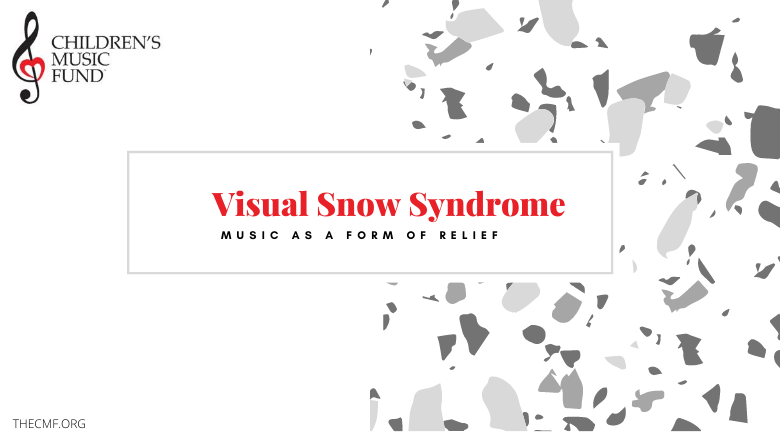
August 30, 2020 | Blogs and News
By Mireille Karadanaian — 1 min read — Visual Snow Syndrome and Music Therapy
It’s difficult living like I’m looking through a lens. From the moment I wake up to the moment I sleep, my vision is plagued with dots, like a flurry of snow. The blizzard is so strong it’s difficult to see, to find relief and to engage in basic activities like watching TV. After many doctor visits, I found out I have Visual Snow Syndrome.
Visual Snow is a rare and unknown neurological disease. The synapses fired between the brain and eyes get disrupted and although they cause no damage, they result in the painful and uncomfortable distortion of one’s vision. Your entire field of vision is like you’re seeing everything through a snowstorm or perhaps it looks like you’re watching your life through the static of a TV.
Beside the persistent positive aural phenomenon, symptoms include palinopsia, photo phobia and impaired night vision. Causes are unknown and every patient experiences the syndrome differently. Usually the symptoms tend to appear during the stages of puberty, and intensify as they get older. Currently, no cure exists, but certain experimental therapies have been known to provide temporary relief.
When I got diagnosed with Visual Snow, I lost all hope of a normal life. I had to give up my favorite things like reading, because focusing on the tiny words made the illusion worse. I struggled doing my daily work because staring at the computer screen for hours made the symptoms more painful.
Even the journey to a diagnosis was difficult, because all the ophthalmologist exams and brain MRIs appear normal. Since the work showed no noticeable disease, I spent years wondering what could then be causing this distortion.
I thought it would be impossible to regain my sense of self, but my father reminded me that just because one sense wasn’t working as well, my eyesight, didn’t mean the others weren’t. In fact, he said I should rely on my other senses to guide me and bring me peace.
Music For Relief
Sometimes the Visual Snow was so heavy I couldn’t open my eyes and other times the stress and despair would weigh down upon me like a suffocating blanket. That’s when I turned to music. During my half hour of Music Therapy, as my record spun and I listened to my favorite artist, it seemed that my vision was finally clear, the sky was clear—my path was clear.
I focused on the words and the story they weaved together. I focused on the raw emotion and power behind the singer’s voice that spoke of strength and resilience. For hours and hours a day, my only refuge would be losing myself in a song.
Sometimes I listened to upbeat music, using it to reinvigorate my body and mind and inspire me to rise above my condition. At other times I found solace in listening to sad, melancholic music that spoke of pain and uncertainty, as the lyrics resonated with me.
Music became my therapy—no actual psychiatrist or ophthalmologist could have provided me with more relief than the soothing words of Billie Eilish, one of my favorite singers, or the soft, easy rhythm of an orchestral piece.
Over time, I found my mood improving and hope blossoming. I felt the promise that maybe with the help of music and other positive forces like my family, I could redefine my life. Adjustments had to be made, my vision wasn’t capable of the same feats anymore. However, anytime I felt discouraged or alone, I turned to a song and found the feelings dissipate.
Music Therapy has been proven to help manage associated symptoms for other vision-related ailments by providing a sense of peace, lowering a patient’s depressive symptoms and improving the quality of vision.
A study conducted by the Imperial College London linked Music Therapy to a stroke patient’s restoration in vision. The brain’s areas critical in integrating vision, awareness, and action are disrupted during a stroke, resulting in visual neglect. The patient experiences an inability to focus on objects in the opposite side of space from their injury. Despite this insult, by listening to their favorite music, patient’s showed an improvement in visual awareness that doctors linked to the positive emotions experienced during the session.
Even though there lacks a solution for me, what ties me into the Visual Snow community is an unwillingness to give up. Support groups such as the Visual Snow Initiative work hard to provide patients with a welcoming and encouraging platform that offers hope for solutions while decreasing people’s sense of loneliness.
It has been two years since my diagnosis of Visual Snow and I have learned a lot about myself and Music Therapy. It’s easy to give up and let medical and external factors undermine you, but things like music can reintroduce confidence and the aspiration that by thinking more positively and relying on it’s transformative power, things will get better!
To support our CMF Kids who are also in need of the benefits of Music Therapy, donate here!
